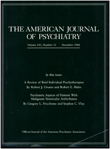Use of a structured diagnostic interview to identify bipolar disorder in adolescent inpatients: frequency and manifestations of the disorder
Abstract
The authors interviewed 17 adolescent inpatients and their mothers with the Schedule for Affective Disorders and Schizophrenia for School-Aged Children and Adolescents, Epidemiological Version (K-SADS-E), a semistructured interview that generates RDC and DSM-III diagnoses for major affective disorders and nonaffective psychoses and DSM-III diagnoses for dysthymic, cyclothymic, and other selected disorders. Five of the patients (29%) satisfied DSM-III criteria for bipolar disorder or atypical bipolar (bipolar II) disorder, although these diagnoses had not been identified in the hospital charts. These data support previous findings that bipolar disorder occurs moderately frequently in adolescent inpatients, although it is often unrecognized. Moreover, the disorder can be readily identified with structured diagnostic methods.
Access content
To read the fulltext, please use one of the options below to sign in or purchase access.- Personal login
- Institutional Login
- Sign in via OpenAthens
- Register for access
-
Please login/register if you wish to pair your device and check access availability.
Not a subscriber?
PsychiatryOnline subscription options offer access to the DSM-5 library, books, journals, CME, and patient resources. This all-in-one virtual library provides psychiatrists and mental health professionals with key resources for diagnosis, treatment, research, and professional development.
Need more help? PsychiatryOnline Customer Service may be reached by emailing [email protected] or by calling 800-368-5777 (in the U.S.) or 703-907-7322 (outside the U.S.).



